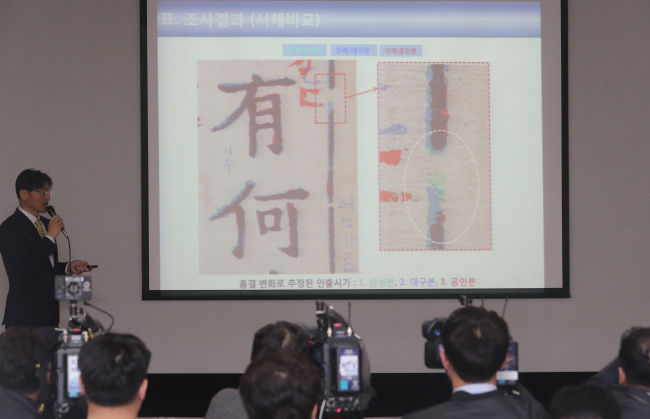Ancient metal print types not used for ‘Jeungdoga’
By Hong Dam-youngPublished : April 13, 2017 - 18:23
The Cultural Heritage Administration on Thursday decided not to register “Jeungdogaja” as a national treasure, after examination results confirmed that they could not be the 13th-century metal print types used to print “Jeungdoga.”

However, the agency said it was still possible that they are metal types from the same time period, although their tests were inconclusive on that point.
Professor Nam Kwon-heui of Kyungpook National University and the Korean Antiques Association chief Kim Jong-chun-- who revealed the types to the public in 2010 -- claimed that the 101 movable types were used to print “Nammyeongcheonhwasangsongjeungdoga (Sermons of Buddhist Priest Nam Myeongcheon),” or “Jeungdoga.”
If confirmed, they would have been verified as the world’s oldest movable metal types. It would have preceded “Jikji” -- the UNESCO-designated Korean document known as the world’s oldest extant book printed with movable metal type -- by 138 years.
“The examination committee (of the CHA) turned down the request to register the set of print types as a national treasure because it is not thought to be Jeungdogaja. It is possible that they were made during the times of the Goryeo Dynasty,” said Hwang Kwon-soon, the director of tangible cultural heritage division at the CHA.
A copy of the same sermons printed using wooden print blocks from the Goryeo Dynasty is designated as a national treasure and is currently owned by Samseong Museum of Publishing. This print version was used during the examination process.
The state-run body ran a test to see if it would be possible to print the “Jeungdoga” by using the metal types. But they found that it was possible to fit only 14 movable types into one line of the frame used for printing; there are 15 characters per line in the printed version, meaning that it would have been impossible to print the text using the metal types that were examined.
An analysis of the writing style on the types showed that it did not match those on the print version.
However, a carbon dating analysis of the ink stain on the types did confirm previous findings -- including those by the Korea Institute of Geoscience and Mineral Resources in 2011 -- which found the types to have been made between the 11th and 13th centuries.
The CHA committee, however, concluded that this was not enough to conclude that the metal types were not an elaborate forgery, as it was possible to fabricate such ink using modern technology.
“Some members said that by using a tree that existed during the Goryeo period, it is possible to create ink with identical composition,” said Hwang. The committee also raised questions about how the artifacts were acquired. “While we have found no evidence that the metal types are fake, this does not necessarily mean that they are real,” the CHA concluded.
If the metal types had been confirmed to have been made before the 14th century, they would have been known as the oldest movable metal types in the world as “Jikji” is thought to have been printed in 1377.
The administration said it would continue the process of verifying the authenticity of the metal types, including collaboration with other countries.
Nam blasted the results, saying that the carbon dating makes it clear that the metal types were made during the Goryeo Dynasty. He added that there is no evidence that the types were forged.
“Talks of (the types) being fabricated were sparked by those in the art circles who are hostile toward KAA chief Kim,” Nam said.
By Yoon Min-sik (minsikyoon@heraldcorp.com)
Professor Nam Kwon-heui of Kyungpook National University and the Korean Antiques Association chief Kim Jong-chun-- who revealed the types to the public in 2010 -- claimed that the 101 movable types were used to print “Nammyeongcheonhwasangsongjeungdoga (Sermons of Buddhist Priest Nam Myeongcheon),” or “Jeungdoga.”
If confirmed, they would have been verified as the world’s oldest movable metal types. It would have preceded “Jikji” -- the UNESCO-designated Korean document known as the world’s oldest extant book printed with movable metal type -- by 138 years.
“The examination committee (of the CHA) turned down the request to register the set of print types as a national treasure because it is not thought to be Jeungdogaja. It is possible that they were made during the times of the Goryeo Dynasty,” said Hwang Kwon-soon, the director of tangible cultural heritage division at the CHA.
A copy of the same sermons printed using wooden print blocks from the Goryeo Dynasty is designated as a national treasure and is currently owned by Samseong Museum of Publishing. This print version was used during the examination process.
The state-run body ran a test to see if it would be possible to print the “Jeungdoga” by using the metal types. But they found that it was possible to fit only 14 movable types into one line of the frame used for printing; there are 15 characters per line in the printed version, meaning that it would have been impossible to print the text using the metal types that were examined.
An analysis of the writing style on the types showed that it did not match those on the print version.
However, a carbon dating analysis of the ink stain on the types did confirm previous findings -- including those by the Korea Institute of Geoscience and Mineral Resources in 2011 -- which found the types to have been made between the 11th and 13th centuries.
The CHA committee, however, concluded that this was not enough to conclude that the metal types were not an elaborate forgery, as it was possible to fabricate such ink using modern technology.
“Some members said that by using a tree that existed during the Goryeo period, it is possible to create ink with identical composition,” said Hwang. The committee also raised questions about how the artifacts were acquired. “While we have found no evidence that the metal types are fake, this does not necessarily mean that they are real,” the CHA concluded.
If the metal types had been confirmed to have been made before the 14th century, they would have been known as the oldest movable metal types in the world as “Jikji” is thought to have been printed in 1377.
The administration said it would continue the process of verifying the authenticity of the metal types, including collaboration with other countries.
Nam blasted the results, saying that the carbon dating makes it clear that the metal types were made during the Goryeo Dynasty. He added that there is no evidence that the types were forged.
“Talks of (the types) being fabricated were sparked by those in the art circles who are hostile toward KAA chief Kim,” Nam said.
By Yoon Min-sik (minsikyoon@heraldcorp.com)




















![[Today’s K-pop] BTS pop-up event to come to Seoul](http://res.heraldm.com/phpwas/restmb_idxmake.php?idx=642&simg=/content/image/2024/04/17/20240417050734_0.jpg&u=)